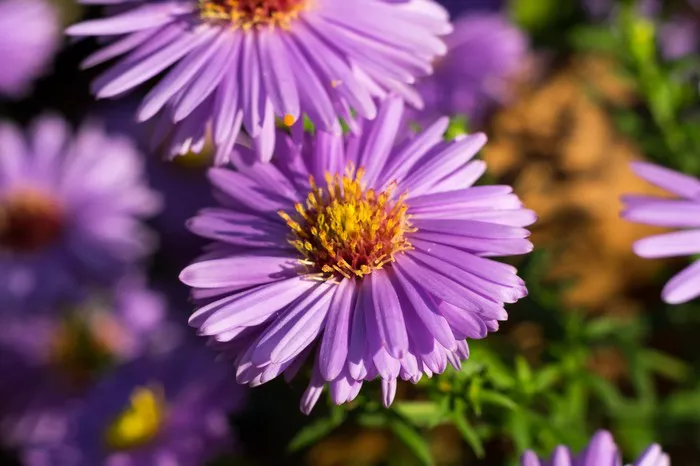Asters, with their delicate petals and vibrant hues, have captivated humanity for centuries. These enchanting flowers hold significant meanings across various cultures and have found their way into gardens, art, and literature worldwide. In this comprehensive exploration, we delve into the rich symbolism and cultural significance of the aster flower.
Origins and Botanical Characteristics
Before delving into the symbolic meanings of asters, it’s essential to understand their origins and botanical characteristics. Asters belong to the Asteraceae family, which includes over 600 species, with the most common being the Aster Amellus, or Michaelmas daisy, and Aster Novi-belgii, commonly known as New York asters. These perennial plants are native to Europe, Asia, and North America, thriving in a variety of habitats, from meadows to rocky slopes.
Aster flowers are renowned for their daisy-like appearance, characterized by a central disc surrounded by colorful ray florets. The petals come in a spectrum of shades, including vibrant purples, pinks, blues, and whites, adding to their allure. Their name, “aster,” is derived from the Greek word for “star,” aptly describing the star-shaped appearance of their blooms.
Symbolism Across Cultures
Throughout history, asters have held diverse symbolic meanings across different cultures, often representing sentiments of love, patience, and healing. Let’s explore the significance of aster flowers in various cultural contexts:
1. Ancient Greek Mythology:
In ancient Greek mythology, aster flowers were associated with the goddess Astraea, who personified innocence and purity. Legend has it that when Astraea became the constellation Virgo, she scattered stardust across the earth, transforming them into aster flowers. Thus, asters came to symbolize the goddess’s tears of sorrow for humanity’s descent into darkness.
2. Chinese Culture:
In Chinese culture, asters are revered as symbols of love and fidelity. They are often exchanged between lovers as tokens of affection, representing the desire for a lasting and faithful relationship. Additionally, asters are believed to bring good luck and ward off evil spirits, making them popular choices for weddings and other auspicious occasions.
3. Native American Traditions:
Among Native American tribes, asters were prized for their medicinal properties and spiritual significance. The Navajo people used aster extracts to treat various ailments, including respiratory issues and inflammation. Additionally, asters were regarded as symbols of protection and guidance, with their bright blooms believed to attract benevolent spirits and ward off negative energies.
4. Victorian Era Symbolism:
During the Victorian era, the language of flowers, or floriography, was popularized as a means of conveying sentiments and emotions through floral arrangements. Asters were often included in bouquets to express admiration and appreciation, symbolizing elegance, refinement, and daintiness. Depending on the color, asters could convey different meanings, with purple asters signifying wisdom and enchantment, while white asters represented innocence and purity.
5. Modern Interpretations:
In contemporary times, asters continue to hold symbolic significance, albeit with nuanced interpretations. They are often associated with sentiments of patience, understanding, and inner strength, serving as reminders to persevere through life’s challenges. Additionally, asters are cherished for their ability to attract pollinators, such as butterflies and bees, symbolizing the interconnectedness of all living beings and the importance of environmental stewardship.
Cultural References in Art and Literature
The timeless beauty and symbolism of aster flowers have inspired artists and writers throughout history, leaving an indelible mark on various artistic mediums:
1. Vincent van Gogh:
Renowned Dutch painter Vincent van Gogh immortalized asters in his masterpiece, “Still Life: Vase with Asters and Phlox,” painted in 1886. The vibrant colors and intricate details of the asters reflect van Gogh’s fascination with nature’s beauty and his mastery of color theory.
2. Emily Dickinson:
American poet Emily Dickinson frequently referenced asters in her poetry, using them as metaphors for beauty, resilience, and the passage of time. In her poem “Nobody knows this little Rose,” Dickinson muses on the fleeting nature of life, likening the delicate aster to a “Scarlet creature.”
3. Georgia O’Keeffe:
American artist Georgia O’Keeffe captured the essence of asters in her iconic floral paintings, where she magnified their intricate forms to reveal their innate beauty and complexity. O’Keeffe’s asters evoke a sense of reverence for the natural world, inviting viewers to contemplate the sublime in everyday objects.
Conclusion
In conclusion, aster flowers are not merely botanical specimens but symbols of profound meaning and cultural significance. Acrosscultures and throughout history, these enchanting blooms have inspired awe and admiration, serving as reminders of love, resilience, and the interconnectedness of all living beings. Whether adorning gardens, adorning artworks, or conveying sentiments through floriography, asters continue to enchant and captivate humanity with their timeless beauty and symbolism. As we gaze upon their star-like blooms, may we be reminded of the enduring power of nature to inspire, heal, and uplift the human spirit.


